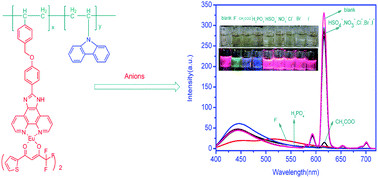An efficient long fluorescence lifetime polymer-based sensor based on europium complex as chromophore for the specific detection of F−, CH3COO−, and H2PO4−†
Abstract
A novel long fluorescence lifetime europium-complexed copolymer (Eu-polymer) has been designed and synthesized via the classic free radical copolymerization reaction as an efficient fluorescent sensor for F−, CH3COO−, and H2PO4−. The anions-sensitivity of Eu-polymer was evaluated using a series of anions in DMSO solution. On binding to F−, CH3COO−, or H2PO4−, fluorescence quenching of Eu-polymer was demonstrated by an approximately 95% reduction in the fluorescence intensity, while no obvious fluorescence change could be observed in the presence of other anions. Compared with its small molecular counterpart, Eu-polymer exhibits higher sensitivity and selectivity. Most importantly, the Eu-polymer sensor can efficiently recognize and sense F− even in the presence of competitive anions, such as CH3COO− and H2PO4−, which demonstrates the ability of Eu-polymer to function as a selective fluorescence sensor for F−. The fluorescence quenching can be attributed to the strong hydrogen bonding interaction (and deprotonation interaction at high concentration for F−) between anions and the imidazole group of Eu-polymer. Due to the long fluorescence lifetime of this Eu-polymer, it can efficiently eliminate the effects of auto-fluorescence and light scattering from surrounding biological environments, so this sensor will be very significant for application in biological and environmental fields.


 Please wait while we load your content...
Please wait while we load your content...